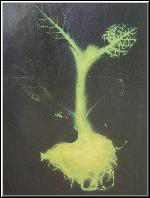Date: Sun Nov 5 19:24:16 2000
Posted By: Evelyn Tsang, Research Assistant
Area of science: Molecular Biology
ID: 971609107.Mb
Message:
Hello Hina!
Did you know that there already are transgenic plants which glow?!
The glow-in-the-dark genes come from sources such as fireflies, jellyfish
and phosphorescent bacteria.
As pretty as they may be, plants have not been modified to glow-in-the-
dark for aesthetic reasons. Phosphorescent genes have been introduced
into plants as "reporter genes".
Scientists put new genes into a plant with the hopes of improving various
qualities. The gene is attached to a "vector" which should be able to
slip into the plant cell and get carried along as a part of the cell's
DNA. If all works well, the gene will be treated as though it were always
a part of the cell's genome. However, this does not always happen. The
vector may not be able to get into the cell, or may be stopped by the
cell's defense system. In order to locate the successfully transformed
cells, a second gene is attached to the first one. This second gene will
produce something that can be easily observed. One typical product is an
antibiotic resistance; only transformed cells will grow when the
antibiotic is added to the cells. This second gene is called a "reporter
gene".
Instead of antibiotic resistant reporter genes, some scientists have
started using phosphorescent reporter genes. The genes taken from the
firefly and bacteria are the luciferase enzymes. When these enzymes break
down the substrate luciferin, light is produced. The genes taken from
jelly fish are called green fluorescent proteins. These genes need a blue
light (or UV light) and calcium in order to glow in the dark.
So to summarize, the "glow-in-the-dark" gene and another gene are attached
to a vector which is introduced into a plant cell. The vector should
insert the genes into the cell genome. When a plant grows from the cell,
adding the right substances (light and calcium or luciferin) will cause
the plant to glow in the dark.
I hope this helps you in answering your friend's question!
Thanks for asking!
Evelyne

This photo of a plant containing the luciferase enzyme is from the
website: http://kazza.cia.com
.au/website/luciferase.html
For some nifty photos of plants with the green fluorescent protein
inserted, see this site: http://www.oardc.ohio-
state.edu/plantranslab/gfp.htm
Here are a list of web references that I used:
Dr. Haseloff and his lab, Background on Green Fluorescent Protein http://w
ww.plantsci.cam.ac.uk/Haseloff/GFP/GFPbackgrnd.html
"Shedding light on how jellyfish glow"
Diedtra Henderson , Seattle Times science reporter http://seattletimes.nwsource.com/news/health-
Science/html98/jell_071498.html
"FAQ for Green Fluorescent Protein (GFP)",
Gayle Callis HT,HTL(ASCP)MT Veterinary Molecular Biology,
Montana State University, Bozeman, MT 59717-3610 http://www.histology.to/GFPfaq.h
tml
"Video Imaging of Regulated Firefly Luciferase Activity in Transgenic
Plants and Drosophila"
Steve A. Kay - Andrew J. Millar, Kenneth W. Smith, Shawn L. Anderson NSF
Center for Biological Timing Department of Biology Gilmer Hall University
of Virginia Charlottesville, VA 22901
Christian Brandes, Jeffrey C. Hall NSF Center for Biological Timing
Department of Biology Brandeis University Waltham, MA 02254 http://www.promega
.com/pnotes/49/2788d/2788d.html
"Plant Transformation by Lux+ Agrobacterium"
Anna Szenthe and William J. Page
Department of Biological Sciences M-341 Bio Science Bldg.
University of Alberta Edmonton, Alberta T6G 2E9 http://www.zoo.utoronto.ca/able/volumes/vol-19/07-szenthe/07-
szenthe.htm
Current Queue |
Current Queue for Molecular Biology |
Molecular Biology archives
Try the links in the MadSci Library for more information on Molecular Biology.
MadSci Home | Information |
Search |
Random Knowledge Generator |
MadSci Archives |
Mad Library | MAD Labs |
MAD FAQs |
Ask a ? |
Join Us! |
Help Support MadSci
MadSci Network,
webadmin@www.madsci.org
© 1995-2000. All rights reserved.
